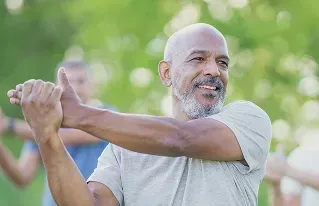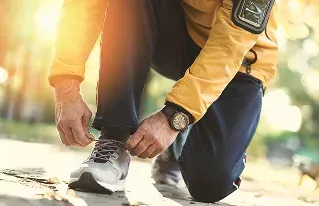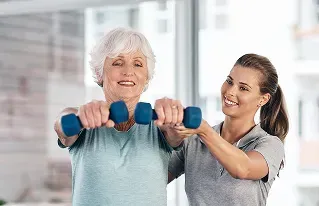If you have arthritis, you might not exercise anymore. Many arthritis sufferers worry that exercise will worsen their aches and pains. But according to the Arthritis Foundation, experts say the real concern is not exercising at all, which makes your joints more stiff, painful and prone to injury.
It might sound counterintuitive, but physical activity is among the most successful of all arthritis treatments.
Why? Because among the many health benefits it offers — including improved heart health and the potential for better blood sugar and blood pressure control — exercise can actually:
- help reduce the pain, inflammation and fatigue associated with arthritis, and
- strengthen bones, muscles and joints — including the muscles, ligaments and tendons around the joints, which act like a brace to protect them.
Which type of exercise is important …
In general, a well-balanced exercise regimen that includes cardio and strength training, along with mobility and balance work, will give you several benefits.
You might walk one day, swim another day, lift weights or perform another type of resistance training a couple times a week, and do balance and flexibility exercises like Tai chi or Pilates at least once a week.
But there’s no one best exercise for arthritis. Some people may find certain exercises are better for them than others because they enjoy them and are more likely to do them regularly. Other folks might find their body responds well to certain exercises, and they feel better afterward with minimal soreness.
2 quick tips for safely starting your exercise program
-
Check in with your doctor.
If you’re not exercising now, but would like to, be sure to check with your doctor or physical therapist before beginning your new exercise program. He or she can advise you on which type of exercise might be most beneficial for you, as well as specific exercises.
-
Warm up!
Before you begin any exercise, warm up for at least five minutes beforehand. Avoid stretching, which can injure cold muscles. Instead, try a quick walk or a few range-of-motion exercises, like arm, neck and ankle circles. Range-of-motion exercises are crucial for people with arthritis because they keep joints strong and flexible.
Here’s a brief look at two of the types of exercise the Arthritis Foundation recommends — cardio and strength training.
Cardio
Cardio or aerobic exercise is anything that raises your heart rate and gets your blood pumping so it can deliver oxygen and nutrients to every part of your body, including your joints. In addition to the benefits for your body, for some people, aerobic exercise releases natural cannabinoids (known as “endocannabinoids” — biochemical substances similar to cannabis but naturally produced by the body) that help relieve anxiety and depression.
Walking is probably the easiest and least expensive form of exercise. You don’t need special equipment — just comfortable walking shoes or running shoes with a wide toe box and good support.
The benefits of exercise — for your body and your mind — can’t be overstated
If you need more motivation to exercise in spite of arthritis achiness, consider this: A study of patients with rheumatoid arthritis found those who exercised regularly during the pandemic fared better psychologically than those who didn’t. There are many reasons why people’s mental health was tested during that time. As such, many of us — with and without arthritis — put exercise on the back burner. Just another gentle reminder to keep moving!
Strength training
Unfortunately, we lose muscle mass as we age. That’s why strength training is crucial for building the muscles that support and protect joints. Strength training, along with plenty of protein (ask your doctor how much protein you should be consuming daily) is the best way to regain lost muscle and prevent future loss. Exercise machines, free weights, resistance bands, and your own body weight are all forms of strength training.
A few things to keep in mind:
- If possible, schedule a session with a physical therapist or personal trainer so they can show you the proper form so you can avoid injury. Or, check out free, online videos that show you exactly how to perform specific strength training exercises.
- The Arthritis Foundation’s Your Exercise Solution videos offer arthritis-friendly lower-body exercises, upper-body strengthening using resistance bands, simple core workouts and more.
- Start with light weights. Choose weights you can lift with perfect form for eight to 12 repetitions or for 60 seconds. Form is more important than the number of reps.
- If possible, schedule a session with a physical therapist or personal trainer so they can show you the proper form so you can avoid injury. Or, check out free, online videos that show you exactly how to perform specific strength training exercises.
- The Arthritis Foundation’s Your Exercise Solution videos offer arthritis-friendly lower-body exercises, upper-body strengthening using resistance bands, simple core workouts and more.
- Start with light weights. Choose weights you can lift with perfect form for eight to 12 repetitions or for 60 seconds. Form is more important than the number of reps.
- If you have arthritis in your hands or lack the strength to grip weights, exercise bands are a great alternative. They come in many different sizes and strengths, so it’s easy to switch them out as you get stronger.
- If your joints are painful, save weights for another day. Instead, try a wall squat, which strengthens the quadriceps, the muscles that support the knee joints.
- If possible, schedule a session with a physical therapist or personal trainer so they can show you the proper form so you can avoid injury. Or, check out free, online videos that show you exactly how to perform specific strength training exercises.
- The Arthritis Foundation’s Your Exercise Solution videos offer arthritis-friendly lower-body exercises, upper-body strengthening using resistance bands, simple core workouts and more.
- If you have arthritis in your hands or lack the strength to grip weights, exercise bands are a great alternative. They come in many different sizes and strengths, so it’s easy to switch them out as you get stronger.
- If your joints are painful, save weights for another day. Instead, try a wall squat, which strengthens the quadriceps, the muscles that support the knee joints.
- Start with light weights. Choose weights you can lift with perfect form for eight to 12 repetitions or for 60 seconds. Form is more important than the number of reps.
- If you have arthritis in your hands or lack the strength to grip weights, exercise bands are a great alternative. They come in many different sizes and strengths, so it’s easy to switch them out as you get stronger.
- If your joints are painful, save weights for another day. Instead, try a wall squat, which strengthens the quadriceps, the muscles that support the knee joints.
While it’s important to stay active, don’t push yourself if you’re feeling worse than usual — and let your doctor know. But if you’re feeling “just” the regular aches of arthritis, try to keep moving with exercise you enjoy to help relieve your pain, increase your mobility, and improve your health.






